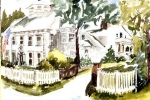CHATFIELD HOLLOW STATE PARK
Hike the trails in search of Indian caves, explore the jagged rocky ledges and recesses or relax by the cooling waters, or picnic in the soft pine woods at Chatfield Hollow State Park.
Geology
All of the bedrock found in the park is a hard, light-colored granitic-type rock called the Monson Gneiss. Originally it was a granitic igneous intrusion formed at the edge of the North American continent as the Iapetos Ocean, which was roughly in the area now occupied by the Atlantic Ocean, was being forced down under the North American continent. Africa and Europe/Asia were moving toward North America. As the ocean floor plate was subducted under the continental plate, some of it melted and forced its way toward the surface. The rock we now see as the Monson Gneiss was the molten material in the magma chamber, which didn?t make it to the surface and slowly cooled to form a granitic pluton. Later, as the Iapetos Ocean continued to close, either a microcontinent or Africa collided with North America and the pressure and high temperatures produced during this collision and subsequent folding of the rocks caused the metamorphism of the former granitic pluton. Millions of years of erosion of the overlying rocks has now exposed this rock, the Monson Gneiss, at the surface.
Gneiss is a metamorphic rock, which means it formed at great depth where pressures and temperatures were much higher than here on the surface. As the rock reaches the surface due to erosion of overlying rocks, the pressure is released and the rock tends to break in many places. Tree roots widened these fractures, as did water freezing in them and expanding. Glacial ice flowing over the rocks moved some of them. Those rocks moved only a short distance are still angular, just as they broke originally, while those moved a longer distance become more rounded as their corners and edges are broken or ground off.
For a detailed description of the geology of the park, follow the Chimney Trail, blazed in green. Begin near the Nature Trail, on the south side of the road. Almost immediately the trail encounters a large outcrop of Monson Gneiss. This large gneiss outcrop contains a number of small rock-fall caves, one with two entrances. Some of these may have been used as shelters by native Americans. The trail climbs over the south end of the outcrop then runs along its eastern side before crossing the road. Notice all of the fractures in the rock.
The Chimney Trail has large amounts of exposed, all of it named Monson Gneiss It is a medium- to coarse-grained rock, light in color, made up mainly of the minerals plagioclase, quartz and biotite. In some places there are traces of garnet, epidote or magnetite. If you look closely at this rock, so that you get used to how it looks, you can then try to find loose boulders of other rocks in the park. These loose, rounded rocks were moved here by glacial ice between 24,000 and 16,000 years ago. Many of these rounded rocks, called glacial erratics, are also Monson Gneiss, as the ice usually didn't move rocks very far. But you may find a few other rock types.
Rounded rocks found in the forest, especially away from outcrops, were deposited here as the glacial ice melted around 17,000 years ago. Rocks moved by water or ice lose their sharp edges and corners from abrasion and become rounded. These rocks which the glaciers moved are called erratics. Most of the erratics in the park are Monson Gneiss, but sometimes you may find a rock which looks different. At one point along the Chimney trail a reddish-brown rock containing small pebbles can be found. It is a piece of the Portland Arkose which is found to the northeast of Chatfield Hollow, in Durham and farther north. Portland Arkose was quarried in Portland for many years and shipped all around the United States, even to California, to be used as the building stone called "brownstone". The piece seen in the picture is a little hard to identify because of its moss and lichen covering, but a careful examination will reveal the small pebbles it contains. Arkose is a type of sandstone, a sedimentary rock made by the cementing together of grains of sediments.
Chatfield Hollow Brook flows toward Long Island Sound between two high ridges covered with oak, beech, and hickory. In 1934, the Civilian Conservation Corps built an earth and stone dam across the brook, creating seven acre Schreeder Pond. Pines planted at the same time now form a green setting around the pond.In pre-Colonial times, Indians frequented the valley in considerable numbers for purposes of fishing and hunting. Many artifacts found in the vicinity of Indian Council Caves indicated that Native Americans sought refuge in the jagged ledges and held tribal gatherings amid the rock recesses and overhangs. An Indian trail paralleled the brook, winding through the trees and along what is now the park road.
Early settlers made use of the stream for waterpower. Descendants of three Chatfield brothers, who arrived from England about 1639, were believed to have operated a gristmill along the brook. Occasional chunks of oddly shaped metal fragments found near the watercourse are evidence that an iron smelting furnace worked native ores into metal for implements. Other reminders of early history include several old building foundations, a restored waterwheel on the upper pond, and the covered bridge reproduction spanning Chatfield Hollow Brook
Connecticut has made state parks, forests, trails, historic sites and beaches more accessible to our residents so they can enjoy the many attractions and beauty they offer. Under the Passport to the Parks program, parking fees are now eliminated at Connecticut State Parks for those with Connecticut registered vehicles. You can view the
CONNECTICUT PASSPORT TO THE PARKS web page to learn more.

BBs / Inns
Located along the CT Shoreline midway between New York City and Boston, and only one hour from Hartford, with tons of local attractions both on the Long Island Sound and the Connecticut River.
12.5 miles from park*




